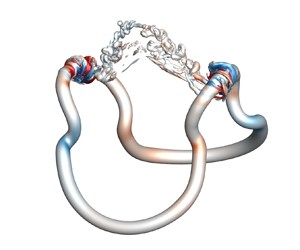Article contents
Evolution of dissipative fluid flows with imposed helicity conservation
Published online by Cambridge University Press: 06 January 2023
Abstract

We propose the helicity-conserved Navier–Stokes (HCNS) equation by modifying the non-ideal force term in the Navier–Stokes (NS) equation. The corresponding HCNS flow has strict helicity conservation, and retains major NS dynamics with finite dissipation. Using the helical wave decomposition, we show that the pentadic interaction of Fourier helical modes in the HCNS dynamics is more complex than the triadic interaction in the NS dynamics, and enhanced variations for left- and right-handed helicity components cancel each other in the HCNS flow to keep the invariant helicity. A comparative study of HCNS and NS flow evolutions with direct numerical simulation elucidates the influence of the helicity conservation on flow structures and statistics in the vortex reconnection and isotropic turbulence. First, the HCNS flow evolves towards a Beltrami state with a  $-4$ scaling law of the energy spectrum at high wavenumbers at long times. Second, large-scale flow structures are almost identical during the viscous reconnection of vortex tubes in the two flows, whereas many more small-scale helical structures are generated via the pentadic mode interaction in the HCNS flow than in the NS flow. Moreover, we demonstrate that parity breaking at small scales can trigger a notable helicity variation in the NS flow. These findings hint that the helicity may not be conserved in the inviscid limit of the NS flow.
$-4$ scaling law of the energy spectrum at high wavenumbers at long times. Second, large-scale flow structures are almost identical during the viscous reconnection of vortex tubes in the two flows, whereas many more small-scale helical structures are generated via the pentadic mode interaction in the HCNS flow than in the NS flow. Moreover, we demonstrate that parity breaking at small scales can trigger a notable helicity variation in the NS flow. These findings hint that the helicity may not be conserved in the inviscid limit of the NS flow.
Information
- Type
- JFM Papers
- Information
- Copyright
- © The Author(s), 2023. Published by Cambridge University Press
References
REFERENCES
- 5
- Cited by


